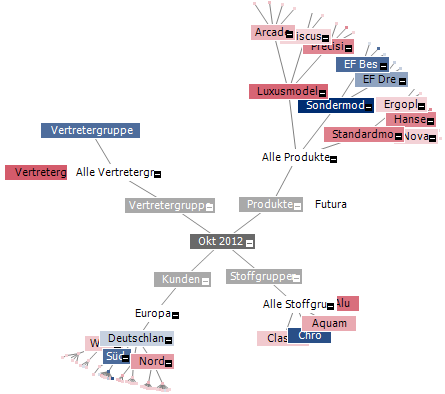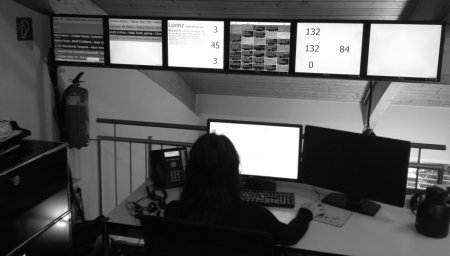You can only tell if something is worth reading after you have already read it. But then you don’t have any more time to read the things that you should. The time we have to read and think is limited and we can’t get all the pigs out of the poke. So how can we, at least, see through the poke? A colleague of mine wanted to know if I had already read his article in our internal database blog. It was about text mining, and I was working on that same topic at the moment. He had sent me an e-mail about it. “Yes and no” was my response. I had read his message but hadn’t looked at the article yet. Since offense is the best defense, I then asked if he included the text of the article in his e-mail. He answered, “No, but I sent a link to it.”
 If only every information offer could be as clear as this: Hyperbolic trees show where it pays to take a closer look before you drill down on the data. Source: DeltaMaster.
If only every information offer could be as clear as this: Hyperbolic trees show where it pays to take a closer look before you drill down on the data. Source: DeltaMaster.
Another colleague who was sitting with us said that our conversation had reminded him of a definition that he had learned during his economics lectures as a student in Bochum:
When evaluating information sources in light of costs and benefits, the decision-maker is often faced with an “information dilemma”. How useful information is – for example, to improve a decision – can only be assessed when the information has been obtained. At that point, however, costs have already accrued.*
Great… so now what? See & Go As a basic rule, we should always strive to create a “see and go” situation as illustrated in the image above and avoid a “go and see” one. If we get benefits by merely looking at the poke, excuse me: the information, we can save our limited attention for something else. Many advertisements, on-board computers, newspapers, and software applications assume that human curiosity is unlimited. We first need to decode ads, press buttons, read articles, and click on icons before we understand how they can help us. That’s too much “go” before the “see”. People are curious but also selective. Since brainwork is strenuous, information with the largest subjective benefit has the greatest chance of grabbing our attention. If we can’t assess the benefits, we just assume there are none and simply look away. Message As we have said before, if you have a message that you can communicate as a headline and a short, clear message, please do so. The message contains a summary, which is sacred among information communication experts. The fact that you have even read this far might have something to do with how the title, summary, headlines, and sub-headlines in this post work together. For centuries, printed newspapers have used these elements as a ladder that guides its readers step by step further into the content and rewards them along the way.
 Its consequent way of communicating information in a hierarchal way is just one reason why Germany’s tabloid newspaper “Bild” is so effective… and influential. You absorb the message even with the shortest glance. Your eyes have no other choice. Source: “Bild”.
Its consequent way of communicating information in a hierarchal way is just one reason why Germany’s tabloid newspaper “Bild” is so effective… and influential. You absorb the message even with the shortest glance. Your eyes have no other choice. Source: “Bild”.
Subject line One channel that inevitably uses up attention is the daily flood of electronic mail. In the true sense of Business Intelligence, we could make almost any e-Mail better by simply choosing the subject line more carefully. In our own company, we use e-mail subject lines as electronic announcements that require no answer. We simply close these mails with EOM (end of message). So how do we write better subject lines? We ask ourselves what information they should contain so that the recipient can understand the most important messages without even having to open it.
| Not like this: | But like that: |
| FW: Release planning Meeting | Meeting for release planning on Dec., 7th |
| Assets Report | Assets: 10 mil., receivables: 2.5 mil. |
| Invitation to next Workshop | Next workshop: Dec., 7th 2012 in Berlin |
| Out of Office | Out of office until Dec., 3rd 2012 |
| Business Week, Nr. 47, p. 78, 79 | Must-read article: Business Week Nr. 47, pp. 78, 79 |
| Incoming order | IO 600’, cumulated Nov.: 3.5” |
To a certain degree, we even use this same approach to monitor our business performance. Controlling liquidity and incoming orders in our midsize company doesn’t literally need any capacity. The effect never ceases to amaze me. Good example: clocks Someone recently gave me a print from Cy Twombly. I temporarily placed the picture on a radiator in the bedroom, where it has remained for quite some time now and covers a clock on the wall. Every time I wonder what time it is, I automatically look there – and then see the picture instead of the clock. The human brain makes associations between places and information – unconsciously but permanently. Normally, that is useful because a clock always shows the time whether you look at it or not. This fact motivated us to do an experiment: We constantly display a series of KPIs and events on the computer screens in our office – with the goal of building motivation.
 A clock also shows the time, even when no one is looking. A few computer Screens are now doing that as well – with information from sales, development, and support. Source: DeltaMaster TickerPortal.
A clock also shows the time, even when no one is looking. A few computer Screens are now doing that as well – with information from sales, development, and support. Source: DeltaMaster TickerPortal.
Exception reporting The concept of exception reporting is still a hot, albeit problematic concept in Business Intelligence. We think little or nothing of the practice of only informing management in an emergency. First of all, we feel that the role of management is not strictly a control function. Secondly, you also have to consider the hysteresis effect, which says that bad news depresses people more than good news makes them happy. In the case of decision-making, negative information reverberates longer than the joy that positive news brings. That’s why meetings always should begin with good news. Otherwise, people tend to underestimate positive things. Managers who only want to receive bad news will become bad Managers – or are so already. Like I am sometimes amazed by the practices of the Facebook generation – especially when I witness them first hand in my own house. Can we determine the value of information from group behavior? Should companies equip their reports with a “Like” button? Perhaps… but only after we have thought long and hard about it and believe for good reason that people must like the report because it is good. So… should we get the pig in a poke? No, unless it’s a see-through poke.
* roughly translated from Bruhn, M., Marketing – Basic information for studies and practical work (in German: Grundlagen für Studium und Praxis), 10th Edition, Wiesbaden 2010, p. 94.
